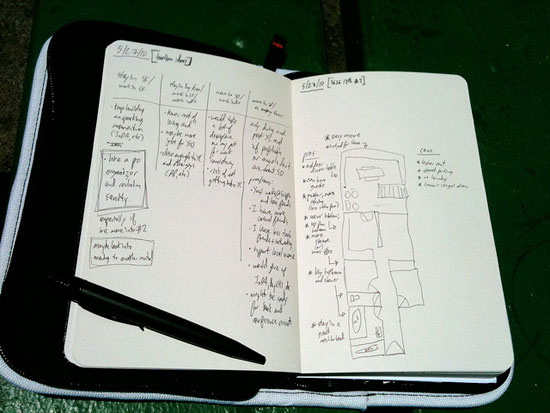Do clients repeatedly ask you to create a website that is beyond the scope of what you can do?

Five Ways To Keep Your Web Design Skills Fresh And In Demand
Since the beginning of the web there has been drastic change in design and development standards. From it’s humble beginnings Google was designed to organize research papers. It has since grown to become the number one portal to everything public on the internet. Likewise, HTML standards have gone through numerous changes thanks to the W3 consortium. Now clients are requesting semantic websites that utilize HTML5 tags and custom XML tags. These custom semantic tags describe what your content is about. Additionally, libraries for JavaScript have been built. Binding events to HTML tags has become very easy; in turn creating expectations that every web developer and designer can add custom effects and animation for their clients. At the beginning, web developers were only expected to create static websites and have a useful form-mail plugin so that clients could be e-mailed comments from visitors or users. Now, web developers are also expected to be able to produce custom dynamic websites. Among the most popular languages for this is PHP. PHP is an actual programming language, unlike markup languages like HTML and CSS and allows for custom form handling, forums, blogs, membership sites and social sites. All in all, web designers are expected to be equipped to meet all of these demands. If you are a freelancer and owner of your business, of course, there is more to know in terms of how to manage the actual business like making relationships with strategic partners that are reliable and have complementary skills. Also, managing prices and being able to meet client expectations so they are left satisfied and want to refer you more work. It’s no wonder many web designers and developers feel ill-equipped with the challenges they face day-to-day and are struggling to take home a healthy profit.
The Proposal: Clients

When a new client calls you, don’t freak out. Do this:
Image you walk into your favourite local small business restaurant. The man taking your order at the front is the owner and you decide to ask him if he has a website for his business. His eyes widen like you are the answer to his sales problems. He says very excitedly, “No I don’t. I’ve been waiting for someone like you to ask!” Then, he literally gets an employee to cover his position and asks if he can sit with you to discuss the possibility of you doing a custom website for him. He uses special ingredients and he wants them all to have descriptions that pop up when people hover over them in his product pictures. He wants his kitchen to use iPads and receive the orders placed from nearby online customers. There is a real heavy feeling in your throat because you can’t deliver the things he’s asking for.
Web designers and freelancers try their best to learn all of the skills they need to learn by piecing together various sources of information. Local community colleges have courses and certificate programs on how to learn HTML and CSS. The advanced classes will teach you that jQuery and PHP exist, but will leave you wanting to know more on how to take a client project from start to end using those types of technologies. Many freelancers are self taught. They pick up books from large retailers like Amazon and type out examples. Most people tend to give up because they don’t have any positive reinforcement to keep going, get overwhelmed and feel like there is too big of an uphill battle to actually being capable of producing something of value for a real client.
After all, expectations of what can be done with today’s web is at an all time high.
The Preparation: Learning
From Nothing to Something: Story of a Self-Taught Designer
Many designers have taken the unstructured approach to teaching themselves by using YouTube videos on any specific topic. This can be helpful depending on how you learn but you may find your time being spent on searching. Much like books, these videos teach certain techniques but don’t teach how they all relate to each other to put together a large project and handle client expectations throughout the project. One of the most well structured, cost efficient ways of learning has been subscription websites. Sites like Educator.com have very affordable rates when compared to a local certificate program and have different courses that teach from start to end, but only for a given web language. There is a course on how to build an e-commerce website. But it teaches how to implement a site using someone else’s framework. To build large custom websites you have to be able to deliver all the time no matter what the framework is that the client wants to use. Overall, there is a focus on individual skills but putting them together does not add up to a complete workable knowledge.
There is overwhelming demand for skilled web designers and developers that understand how to produce custom solutions for any business problem. Rates of these entrepreneurs can reach those of many professionals holding advanced degrees. What would it mean to you if you could comfortably produce very large websites? You would be able to satisfy a larger base of clients. People will spread the word about you because you have all the solutions. Of course, you will be in higher demand and charge more for your time. As well, your work will be more manageable and enjoyable!
The Execution: Information Architecture
10 things web developers must know to become truly amazing
Now, imagine you return to the restaurant understanding how to not only build custom websites but provide solutions to business problems. You are glowing with confidence as you accept the job for a premium to what you would ordinarily accept for a basic five page website!
The major discipline that businesses need and that web designers and developers can deliver is that of “Information Architecture“. Paying attention to this body of knowledge, when combined with the skills you already possess, will open up enormous opportunities because it is the art of solving large daunting problems. Design that takes into account how businesses actually operate will provide your clients’ businesses with a competitive advantage because they will manage their information in a far superior way than their competitors. Some of the key things that encompass information architecture is how to identify key users of the website and interviewing them properly so that the correct requirements are gathered from the beginning and not after coding has been complete. There are also some very interesting visuals that can be used to communicate what the website needs to do before investing time and money into activities that aren’t valuable to the client.
Information Architecture 101: Techniques and Best Practices
Look for professionals in your area that have training in information system business analysis and unified modelling language. They may have credentials from certificate programs or studied information technology from a business school. If you want to outsource this service, ensure they are reputable because they will be spending time interviewing the client. They will help you to capture and organize requirements so they are in a format that you can use in development. These skills are guaranteed to increase your profit margin.
I highly recommend learning more about this discipline by getting your hands on books from Amazon and partnering with experienced professionals.
Information Architecture for the World Wide Web: Designing Large-Scale Web Sites
